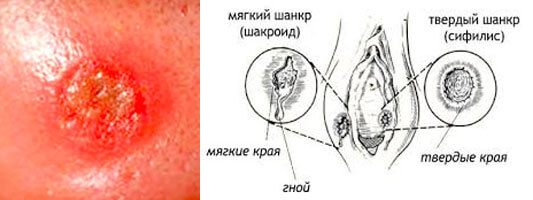Infectious diseases that are sexually transmitted often manifest themselves at the site of the pathogen with specific symptoms.
So, there is a disease chancroid, which is caused by infection with the bacterium Haemophilus ducreyi (Ducrey's wand).
The second name of chancroid – chancre.
Also referred to as Venereal Ulcer and Third STD.
Infection, in addition to the sexual route, can be transmitted by contact - household way.
Read more on estet-portal.com mechanism of development and clinical manifestations of chancre.
- How does infection occur? Risk factors for chancre
- Mechanism of development and histological characteristics of chancre
- What are the symptoms and clinical manifestations of a mild chankra
How does infection occur? Risk factors for chancre
For the first time, soft chancre was described at the end of the 19th century, the disease A was studied in more detail. Ducray and P. Unn.
This sexual infection is frequently reported in Europe, USA, Asia, Africa and Latin America.
Possible infection with subsequent asymptomatic carriage. Infection with mild chancroid increases the risk of HIV infection.
Infection comes from a sick person, or from a carrier of the infection.
Ways of infection – sexual, for all types of sexual relations and contact – household, more often happens in disadvantaged living conditions.
Risk factors for infection with chancre:
- comorbid genital infection;
- uncircumcised male foreskin;
- the presence of allergic reactions on the mucous membranes and on the skin;
- the use of local medicines that provoke irritation of skin;
- casual sex without barrier contraception.
Also, with a soft chancre autoinfection is possible, which happens in asymptomatic patients with non-compliance with the rules of personal hygieneny.
Approaches to the treatment of sexually transmitted infections
Mechanism of development and histological characteristics of chancre
After getting on the mucous membrane or on the skin, Ducray's stick penetrates into the middle of keratinocytes and fibroblasts with the possible formation of extracellular colonies.
In response to this process, pathogenicity factors and surface proteins begin to be produced, which contribute to the appearance of T-lymphocytes and B-lymphocytes in the focus.
Lymphocytes undergo apoptosis.
In the process, granulomatous infiltrate is formed, which is represented by leukocyte masses and the pathogen.
Over time, this infiltrate turns into a ulcer.

Then, the pathogen spreads through the lymphatic tract to the regional lymph nodes, causing the development of periadenitis and soldering of the lymph nodes to each other.
The formed ulcer at the base of is represented by a zone of necrosis, around which there is a perivascular infiltrate of fibrin, erythrocytes and leukocytes.
Deeper infiltrate consists of plasma cells and newly formed blood vesselss.
Read more of our articles on Facebook!
What are the symptoms and clinical manifestations of a chancre
The incubation period for infection with chancre is up to 3 weeks for women, up to a week and a half for men.
Soft chancre is more often localized on the genitals, but can also be in the perianal region, on the inner thighs, in the anus, on the lips and chest. There may be several primary elements of the rash.
First symptom of chancre – swelling and pink spotting, tenderness and enlargement of regional lymph nodes.
This is not accompanied by symptoms of intoxication.
A few days later, a nodule is formed in the projection of the spot , painful on palpation, which later turns into a bubble with purulent contents.
After opening the bladder, a very painful ulcer remains, which has high edges and purulent compartments (chancre).
Touching on an ulcer causes severe pain. The manifestations of a chancre may vary depending on the location.
So, swelling of the scrotum or labia may develop, pain during defecation, urination and sexual intercourse.
It is possible to develop purulent inflammation of the lymph nodes, in which they increase, solder into conglomerates.
Above them the skin is sore and bluish accompanied by fever and chills.
Possible development of destruction of the tissues of the penis with the possibility of self-amputation.
Read our next article about the complications, diagnosis and treatment of chancre.
Latent sexual infections: an invisible danger







Add a comment